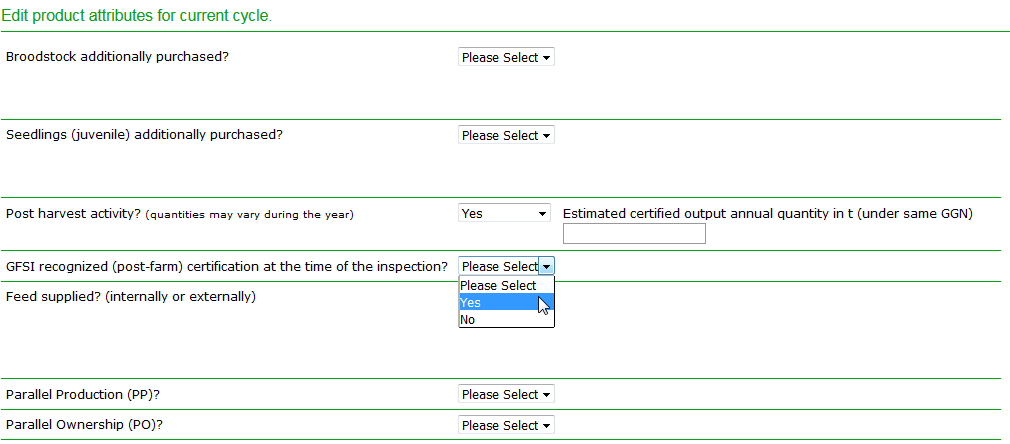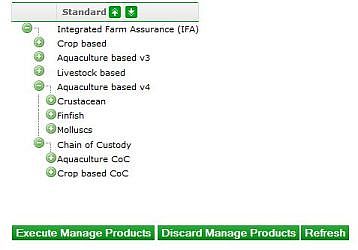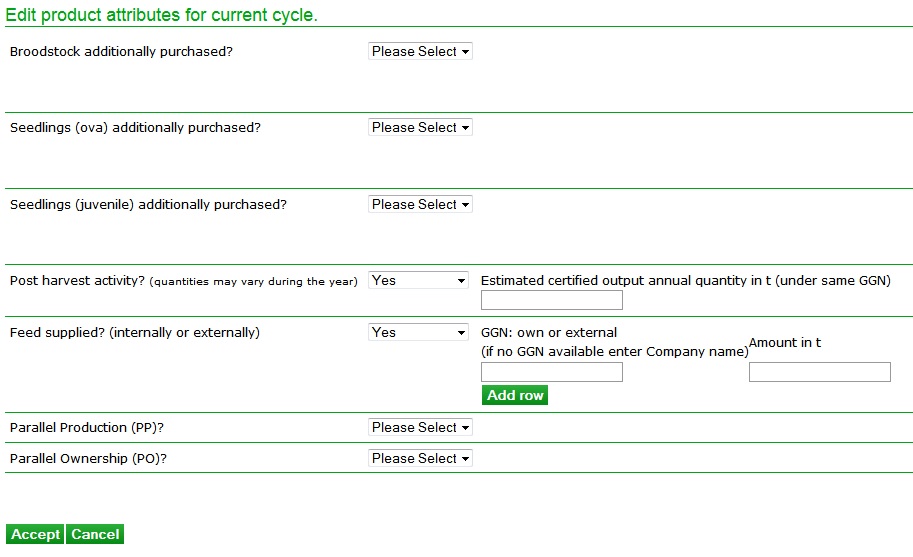Managing the aquaculture scope
New Aquaculture attributes
A new product attribute GFSI recognized (post-farm) certification at the time of the inspection? has been implemented for the aquaculture products. It applies only when you have chosen YES for the post harvest activity.
Aquaculture version 4.0
In the version 4 Aquaculture scope there are 3 subscopes:
- Crustaceans
- Finfish
- Molluscs
Based on market demands and to increase transparency, GLOBALG.A.P. Database developments have been implemented for aquaculture registration for the different life stages of the seedlings.
The quantity “Seedlings” as well as the corresponding attribute “Seedlings additionally purchased?” have been renamed to “Seedlings (juvenile)” and “Seedlings (juvenile) additionally purchased?”. Juvenile refers to: smolt, fingerling, alevin, nauplii, post-larvae, others. For practical purposes, the different names used for the different species have been grouped under “Juveniles”.
In the subscopes crustaceans and molluscs there are three quantity fields:
- broodstock estimated organisms in no.
- seedlings (juvenile) estimated organisms in no.
- farmed fish annual quantity in t
For “Finfish”, an additional quantity “Seedlings (ova)” and a corresponding attribute “Seedlings (ova) additionally purchased?” has been introduced:
- broodstock estimated organisms in no.
- seedlings (ova) estimated organisms in no.
- seedlings (juvenile) estimated organisms in no.
- farmed fish annual quantity in t
Registration of quantities can be changed during the production cycle.
Quantities and attributes
For successful acceptance at least one quantity has to be entered. This enables obtaining certification for only broodstock, only seedlings, only farmed fish or for any combination of these three. The registration fee will be calculated for every quantity based on the current fee table.
The quantities that shall be entered are the number of organisms in in-house production and farmed fish annual quantity in t.
Furthermore it is obligatory to enter, whether broodstock or seedlings are additionally purchased - otherwise the products cannot be accepted. This means, even if the producer does not buy additionally any, this information has to be put as an attribute.
The attribute “Post harvest activity?” has been adapted so that now the “Estimated certified outcome annual quantity in t (under same GGN)” can be specified if applicable. This field applies ONLY for the tonnage estimated under the same GGN of the producer. For Parallel Production – PP cases, where products with GLOBALG.A.P. certified status and different GGNs are subject of post harvest activities at the same facility, this tonnage shall NOT be included.
The attribute “Feed supplied by:” has been renamed to “Feed supplied? (internally or externally)”. It is now possible to indicate via a Yes/No selection if feed is used or not. Also if feed is used, the sources and the obtained amounts can now be made transparent. If feed is supplied internally, this has to be entered by specifying the producers GGN as source of the supplied feed.
This is a new feature in the GLOBALG.A.P. Database. If the icon ![]() is selected, they are shown:
is selected, they are shown:
- Obligatory entries
It is obligatory to select Yes or No for Broodstock additionally purchased? and Seedlings additionally purchased?, furthermore for Post harvest activity?
Please, note: After having selected the first Yes or No, wait till the value is validated and reloaded. Continue then with the second entry and so on.
Have you not entered any quantity for broodstock or seedlings in-house production, Yes has to be selected at least for seedling purchase indicating the product source.
Vice versa, have you chosen No for purchase, there must be a quantity at least for seedlings.
Attributes and quantity information are validated during product acceptance and certification.
All these steps of product and attribute registration can now also be completed with an Excel product upload.
- Voluntary entries
In case Yes is selected for broodstock, it is optional to enter the specific GGN the producer is purchasing from (including the estimated no. of organisms).
Also the GGN of the feed supplier and the purchased quantity are voluntary.
If the producer does not purchase any feed, but produces himself/herself, please, enter the producer´s GGN.
Chain of custody v5
This certification ensures that any product bearing a GLOBALG.A.P. label or sold as a GLOBALG.A.P. certified product is sourced from GLOBALG.A.P. certified farms.
The GLOBALG.A.P. CoC Standard identifies the status of your product throughout the entire process, from farm to retailer. It lays out strict requirements for handling certified products and the proper segregation of certified and non-certified produce in the processing operation units.
The GLOBALG.A.P. Chain of Custody (CoC) Standard gives you the level of transparency and integrity that provides added value to your product and brand in the market and added reassurance to your customers.
The new Chain of Custody version 5 includes a new product grouping: Crops Chain of Custody, Livestock Chain of Custody and Aquaculture Chain of Custody. The products are not separately differentiated anymore. This was done to facilitate the product registration status for the certification bodies.
FAQs
1. Growing period longer than one year/one cycle
As the growing and harvesting period of aquaculture products can go over several months, very often it is not possible to create 1-year-cycles or 1-year-certificates for one product including all growing stages. The option is to enter the new version 4 product(s) e. g. in June and first set up the quantity for broodstock, subsequently the quantity for seedlings and finally for farmed fish during the year - as soon as the respective growing stage becomes applicable. This can be applied every year.
2. Aquaculture species having cycles longer than 12 months
As the growing and harvesting period of aquaculture products can go over several months, very often it is not possible to create 1-year-cycles or 1-year-certificates for one product including all growing stages.
For those aquaculture species that have cycles longer than 12 months, for first audit purposes, registration of number of organisms for seedlings and broodstock as well as harvested tonnage shall be referred to the past 12 months when activites remain the same. Unless there is proof of expansion/reduction in production planned, estimation of annual outcome shall be registered. Inspectors shall have records available to double check quantities at the time of the 1st audit.




